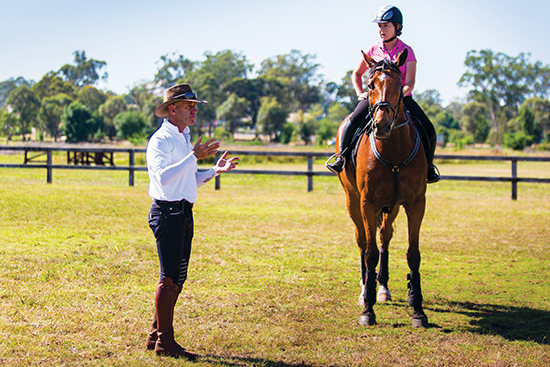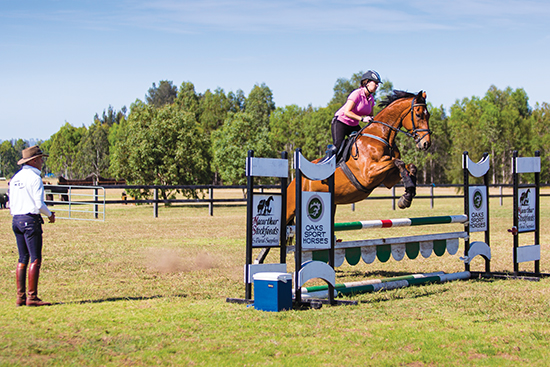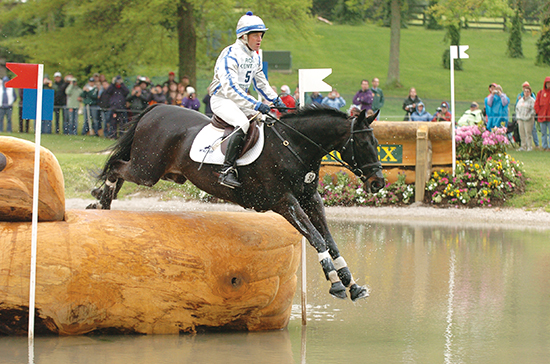VIEW PART ONE HERE:
http://www.horsemagazine.com/thm/2015/03/a-clinic-with-andrew-hoy-part-one/
Story and photos by Rebecca Ashton
Andrew Hoy’s clinic at Camden provided a welcome learning curve for all the participants, even if they did have to battle with weather that was way too hot for comfort…
The first session was about Andrew getting a feel for the horses and riders over poles and showjumps, assessing their knowledge and making sure everything was in order before tackling some solid fences. Molly Peters has already spent quite a bit of time training with Andrew, so she took the opportunity to grab a quick private lesson while the others took advantage of the scant shade for a break, hose off and water intake before the second half.
Andrew started Molly on a big circle with three poles on the circle track. “This is about rhythm and getting the stride right. Keep your hands up and forward with elastic elbows, not down and back.”
Molly and Andrew discuss
Then it was time to test the jumps. “You kept releasing with your hands so he just got longer and longer and slower and flatter. Keep him up in front and balanced. Don’t try to be soft. Jumping isn’t about softness. It’s not about hardness either. It’s about power. You need power to the jump, not speed,” he explained.
“Why was that second jump bad? Because you thought, Andrew said the one before was good and you got too comfortable and thought ah, this is nice. But you let all the power from the first one disappear. Mentally think that you have to jump another fence in between the two jumps to keep your attention. It’s all about the mind!”
By the third go, Molly had it all sorted and Andrew explained why. “The whole thing was great because you made a decision at every point and every decision was different. Press the save button and file that feeling somewhere in your mind. I couldn’t have done it better myself. Ride like that and you’ll have a lot of joy.”
Molly Peters over a jump
Back to the group after the break and Andrew started them on a big circle with three poles like he had started Molly, before each rider played with a few cross country fences, making their own plan of which ones to take.
Everybody had a go but Natalie proved to be a lovely example of how to approach the situation. “Natalie’s horse is growing and growing in confidence because she’s making a nice plan. He had a little trip, just because he’s young and she changed which jump she went to. This is the art of riding.”
“It’s the rider’s job to put the whole plan together because they have all the information. You have to give the horse confidence, not the other way around.”
The final instruction was at the water jump and Andrew wanted the horses to get used to their surrounds. “Walk in the water and then trot and canter. They will find it easier to jump out of the water before they’re confident jumping into it.”
“This is not a game. Ride them through the water at a walk, not like you’re in an armchair, but just as you would at any other pace. As a rider, you need rhythm, balance and core stability. There is never any relaxation, even in a Grand Prix dressage test. Relaxation is sitting in front of the TV.”
“At the trot, keep the same rhythm the whole way through the water.”
Emily Hawker’s horse proved a little challenging so Andrew talked her through the problem. “Emily, what does pulling on the rein mean? Yes, stop. When are you doing it? Midair. Can he stop midair? No! So don’t do it! Go with him! When jumping into the water, think that the bank is just an 80cm landing side of a fence. I haven’t seen you ride a fence like that today, so don’t do it now. You should be keeping the contact but not pulling. As an exercise, let the reins slip through to the buckle when you jump into the water. See how easy it is for him to jump? When you just go with him, he just drops into the water.”
Andrew and Moonfleet
The final piece of ‘water jump’ advice to the group was, “Use your competition as your best reproduction of your training at home. You have to build your horse’s confidence and give them good experiences at home. Horses operate from memory. At a competition, they only see that the jump is water three seconds before they jump it. If you give them a good experience in their training, they’re ok with things, they remember that it was ok last time.”
“Horses don’t care about you. There is not one horse in my stable that knows my name. They just care that they are looked after well and have good experiences. Actually, they know Stef’s name (Andrew’s partner). She’s trained them so well that they hear her voice when she enters the stable and they all pop their heads out and whinny because she’s fed them so many treats! They love her in the stable but that doesn’t mean that they’ll go well for her when she’s on them. I don’t feed treats but they all go very well for me because I give them good experiences in their training.”
By now the mercury was hitting the mid 30s and Andrew decided to finish up a little early. “We could go on but I would only just be saying the same things. You can never work on technique if you or your horse are tired.”
And the final nugget Andrew left the riders with? “You have to believe in yourself!”
A huge thank you must go to Natalie Blundell and Mark Williams for organising the clinic at Camden.
VIEW PART ONE HERE:
http://www.horsemagazine.com/thm/2015/03/a-clinic-with-andrew-hoy-part-one/






